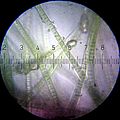Carbon fixation facts for kids
Carbon fixation is a super important process that helps life on Earth! It's how living things, especially plants, turn carbon dioxide gas (CO2) from the air into solid stuff they can use to grow. Think of it like taking a gas and building blocks out of it. This process is a big part of how plants make their own food.
Contents
What is Carbon Fixation?
Carbon fixation is a special way that some living things change carbon dioxide (CO2) from a gas into a solid material. This solid material is then used to build important parts of their bodies, like sugars, proteins, and fats. It's like turning air into food!
Who Performs Carbon Fixation?
The main "fixers" of carbon are plants, algae, and some types of bacteria. These organisms are called autotrophs. This means they can make their own food using energy from the sun (like plants do with photosynthesis) or from chemicals. Animals, including humans, are heterotrophs, which means we need to eat other living things to get our carbon. We can't fix carbon ourselves!
How Plants Fix Carbon: The Calvin Cycle
For plants, the most common way to fix carbon is during a process called the Calvin cycle. This cycle happens inside their cells, usually in special parts called chloroplasts. Here's how it works:
- Plants take in carbon dioxide gas from the air through tiny holes in their leaves called stomata.
- Inside the plant, an important helper molecule called RuBisCO (ribulose-1,5-bisphosphate carboxylase/oxygenase) grabs the carbon dioxide.
- The RuBisCO molecule then attaches the carbon dioxide to another molecule already inside the plant.
- This starts a series of chemical reactions that use energy from sunlight (captured during the first part of photosynthesis) to turn the carbon dioxide into sugars. These sugars are the plant's food!
Other Ways to Fix Carbon
While the Calvin cycle is the most common, some other organisms use different ways to fix carbon. For example, some bacteria that live in places without sunlight can use chemicals to get energy and fix carbon. This is called chemosynthesis.
Why is Carbon Fixation Important?
Carbon fixation is super important for many reasons:
- Food for Life: It's the very first step in making food for almost all living things on Earth. Plants fix carbon, then animals eat plants, and other animals eat those animals. Without carbon fixation, there would be no food chain!
- Oxygen in the Air: When plants do photosynthesis to fix carbon, they also release oxygen into the air. This oxygen is what we and many other animals breathe to live.
- Controlling Climate: Carbon dioxide is a greenhouse gas that traps heat in Earth's atmosphere. By taking CO2 out of the air and turning it into solid stuff, carbon fixation helps control the amount of CO2 in the atmosphere. This is important for keeping Earth's temperature stable.
Carbon Sinks
Places where a lot of carbon is stored are called carbon sinks. Forests, oceans, and even soil are big carbon sinks because they contain a lot of fixed carbon. For example, trees are full of fixed carbon in their wood, leaves, and roots. When we protect forests, we help keep more carbon out of the atmosphere.
Images for kids
-
Cyanobacteria such as these carry out photosynthesis. Their emergence foreshadowed the evolution of many photosynthetic plants and oxygenated Earth's atmosphere.
See also
 In Spanish: Fijación de carbono para niños
In Spanish: Fijación de carbono para niños


